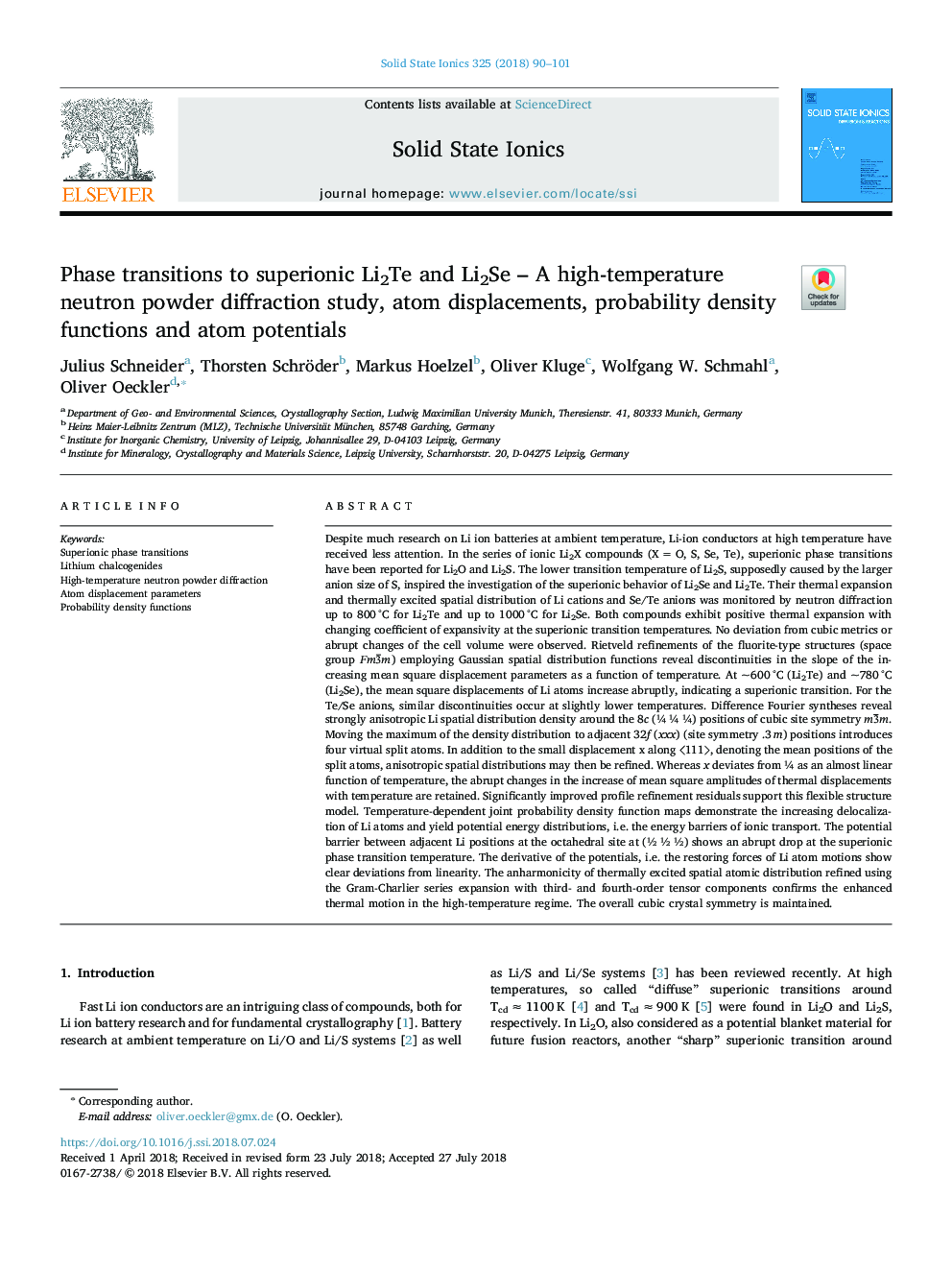| کد مقاله | کد نشریه | سال انتشار | مقاله انگلیسی | نسخه تمام متن |
|---|---|---|---|---|
| 7744170 | 1498218 | 2018 | 12 صفحه PDF | دانلود رایگان |
عنوان انگلیسی مقاله ISI
Phase transitions to superionic Li2Te and Li2Se - A high-temperature neutron powder diffraction study, atom displacements, probability density functions and atom potentials
دانلود مقاله + سفارش ترجمه
دانلود مقاله ISI انگلیسی
رایگان برای ایرانیان
موضوعات مرتبط
مهندسی و علوم پایه
شیمی
الکتروشیمی
پیش نمایش صفحه اول مقاله

چکیده انگلیسی
Despite much research on Li ion batteries at ambient temperature, Li-ion conductors at high temperature have received less attention. In the series of ionic Li2X compounds (Xâ¯=â¯O, S, Se, Te), superionic phase transitions have been reported for Li2O and Li2S. The lower transition temperature of Li2S, supposedly caused by the larger anion size of S, inspired the investigation of the superionic behavior of Li2Se and Li2Te. Their thermal expansion and thermally excited spatial distribution of Li cations and Se/Te anions was monitored by neutron diffraction up to 800â¯Â°C for Li2Te and up to 1000â¯Â°C for Li2Se. Both compounds exhibit positive thermal expansion with changing coefficient of expansivity at the superionic transition temperatures. No deviation from cubic metrics or abrupt changes of the cell volume were observed. Rietveld refinements of the fluorite-type structures (space group Fm3¯m) employing Gaussian spatial distribution functions reveal discontinuities in the slope of the increasing mean square displacement parameters as a function of temperature. At ~600â¯Â°C (Li2Te) and ~780â¯Â°C (Li2Se), the mean square displacements of Li atoms increase abruptly, indicating a superionic transition. For the Te/Se anions, similar discontinuities occur at slightly lower temperatures. Difference Fourier syntheses reveal strongly anisotropic Li spatial distribution density around the 8c (¼ ¼ ¼) positions of cubic site symmetry m3¯m. Moving the maximum of the density distribution to adjacent 32f (xxx) (site symmetry .3â¯m) positions introduces four virtual split atoms. In addition to the small displacement x along ã111ã, denoting the mean positions of the split atoms, anisotropic spatial distributions may then be refined. Whereas x deviates from ¼ as an almost linear function of temperature, the abrupt changes in the increase of mean square amplitudes of thermal displacements with temperature are retained. Significantly improved profile refinement residuals support this flexible structure model. Temperature-dependent joint probability density function maps demonstrate the increasing delocalization of Li atoms and yield potential energy distributions, i.e. the energy barriers of ionic transport. The potential barrier between adjacent Li positions at the octahedral site at (½ ½ ½) shows an abrupt drop at the superionic phase transition temperature. The derivative of the potentials, i.e. the restoring forces of Li atom motions show clear deviations from linearity. The anharmonicity of thermally excited spatial atomic distribution refined using the Gram-Charlier series expansion with third- and fourth-order tensor components confirms the enhanced thermal motion in the high-temperature regime. The overall cubic crystal symmetry is maintained.
ناشر
Database: Elsevier - ScienceDirect (ساینس دایرکت)
Journal: Solid State Ionics - Volume 325, 1 November 2018, Pages 90-101
Journal: Solid State Ionics - Volume 325, 1 November 2018, Pages 90-101
نویسندگان
Julius Schneider, Thorsten Schröder, Markus Hoelzel, Oliver Kluge, Wolfgang W. Schmahl, Oliver Oeckler,